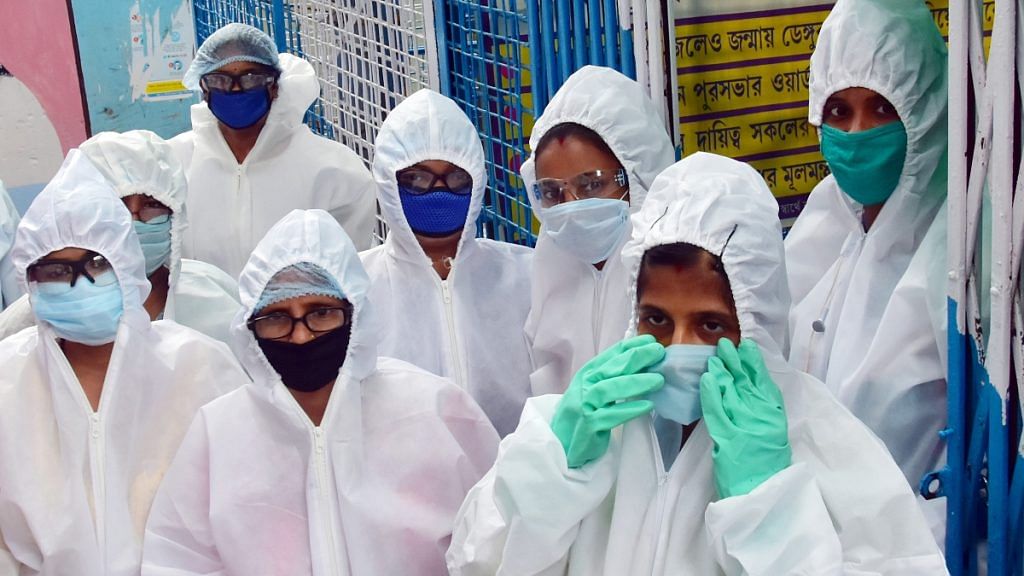New Delhi: With 34,393 cases as of Friday, Maharashtra, Gujarat, Delhi and Rajasthan have the highest number of Covid-19 cases and account for 61 per cent of the country’s total cases. Incidentally, these four states also reported the majority of swine flu or H1N1 cases since 2009.
According to National Centre of Disease Control’s (NCDC) swine flu data, in 2019, the four states had accounted for 55 per cent of the total number of H1N1 cases in the country.
H1N1 and Covid-19 are caused by different viral pathogens, however, both are transmitted through respiratory droplets and have similar symptoms like fever, cough and headaches.
ThePrint analysed data from 2009 to 2019 and spoke to experts to understand why the number of cases and deaths during H1N1 and Covid-19 outbreaks have been higher in certain states and if there is a correlation between the two.
Also read: World’s most accurate antibody test has arrived. Or has it?
What the data shows
Maharashtra, Gujarat, Delhi and Rajasthan have consistently recorded the highest number of swine flu cases since 2009. In 2015, when the biggest outbreak of H1N1 was recorded in India with 42,592 cases, the four states accounted for 26,928 or 63 per cent of the total cases.
When the influenza first hit the country during the 2009-2010 pandemic, Maharashtra (11,408), Delhi (11,164) and Rajasthan (4,742) accounted for most of the cases.
Gujarat was seventh on the list with 2,379 cases but it had recorded the highest number of deaths after Maharashtra. 52 per cent of the total deaths due to swine flu i.e. 1,427 of 2,744 deaths in the country had occurred in just these two states.
During the 2015 outbreak in India, Maharashtra and Gujarat led the count in the number of cases and deaths. The two states accounted for 37 per cent of the total cases and 47.5 per cent of overall swine flu deaths in the country i.e. 1,422 of a total of 2,990 deaths.
In 2017, which saw the highest number of cases and deaths after 2015, Gujarat and Maharashtra recorded over 35 per cent of the cases and 53 per cent of the deaths.
Also read: Focus on Covid-19 to increase malaria, tuberculosis and HIV related deaths in 5 years: Study
More testing, population density could be factors: Experts
According to Dr Lalit Kant, the former head of epidemiology and communicable disease at the Indian Council of Medical Research (ICMR), the “absence of data doesn’t mean the absence of disease”. Instead, he pegs this phenomenon to the high rate of testing in these four states.
“It is just that other states/UTs have neither tested enough for seasonal flu nor are they testing for SARS CoV 2,” he said pointing to the number of labs in each state.
According to NCDC’s data from 2019, the number of virology labs testing for H1N1 influenza in the four states is among the highest — 35 labs were testing for the infection in Maharashtra, 17 in Gujarat, 14 in Delhi and 12 in Rajasthan. Thus, till last year, 78 of the 168 total labs i.e. 46 per cent of all virology labs (both government and private) were testing for H1N1 in these states.
When the Covid-19 pandemic hit, several of these government labs gained approval from ICMR for Covid-19 testing. For instance, eight out of the nine total government laboratories in Gujarat, that had been testing for swine flu, got approval to test for Covid-19.
ICMR’s data indicates that Maharashtra has the highest number of labs with 58 labs followed by Tamil Nadu (52) and Andhra Pradesh (48). Delhi (26), Gujarat (24) and Rajasthan (20) also significantly ramped up its testing facilities.
“Neither seasonal flu nor coronavirus seem to have a special predilection for any environmental, ethnic or genetic factors. These diseases have been found whenever we diligently look for them,” Kant added.
Renowned virologist and former head of ICMR’s Centre for Advanced Research in Virology Dr Jacob John explained a second factor that could explain the higher number of cases in these states— “pockets of high population density”.
“States like Kerala, West Bengal, Uttar Pradesh, and Bihar have the most densely populated states but the concentration of population in places like Mumbai is more,” he said.
Dr John also noted that a possible explanation for this data is that “influenza and Covid are parallel”. He said that both the infectious diseases indicate that there are possible underlying socio-economic factors that determine their spread, and more research needs to be conducted on this.
“This is a subject that the central government should explore because you can have another influenza pandemic coming down the road so it is very important to find these factors,” he said.
It is unclear whether the Covid-19 infections have peaked in India given that a lot remains unknown about the virus. Swine flu, however, usually peaks in the months between January and March and then again in the post-monsoon season from August to October.
Also read: How well has Modi govt’s Covid strategy worked? Answer lies in 1 million+ tests done so far
